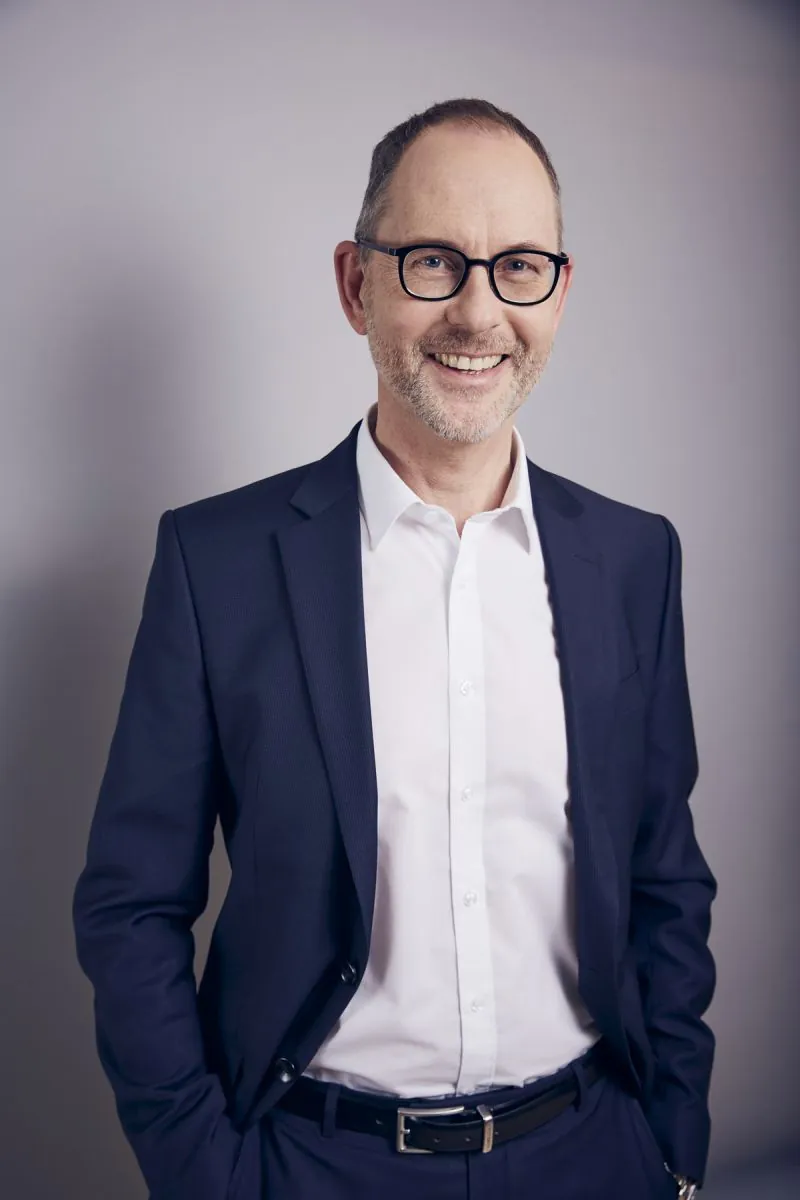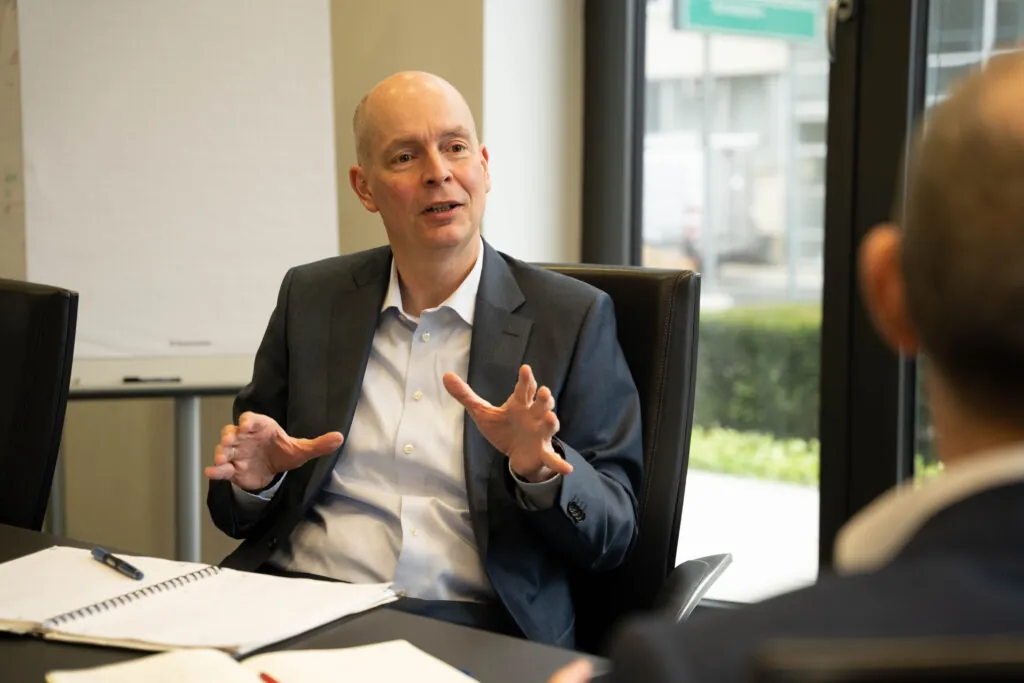
IT Organisation 2025

“IT does not have a monopoly on digitalization”
The interaction between business and IT is a team sport that can only succeed if they work together as partners and as equals. Volker Lang, CIO & Head of Digital Solutions at thyssenkrupp Steel, explains how this works at thyssenkrupp Steel in an interview with Thomas Heinevetter, Managing Director of kobaltblau Management Consultants GmbH.
Various scenarios are conceivable for the IT of the future – What is the trend?
Thomas Heinevetter: Various scenarios are conceivable for the IT of the future: Complete fusion of IT and business, strong fusion, partial fusion, hybrid. What is the trend at thyssenkrupp Steel?
Volker Lang: The IT organization will not disappear at thyssenkrupp Steel. This is because the company does not have a digital business model, rather a heavy industry business model is being digitized. This means mastering a balancing act between agility and stability. Our line organization, including infrastructure, platforms and platform products, ensures this necessary stability. Above this lies a virtual organization, our so-called “digital domains”, in which we bring the business on board, bring together different skills and achieve a high level of agility.
Heinevetter: What characterizes the digital division “Digital Solutions”?
Lang: Like many manufacturing companies, we have organized our business functionally today. The individual functional areas are responsible for specific process steps along our value chain. However, the added value itself is of course always created end to end. In order to achieve company-wide transparency and control capability, it is therefore important to integrate individual functions into digital end-to-end processes and to create a holistic overall picture from the diverse functional perspectives on our business in terms of data technology. We achieve both through the platforms and products provided by Digital Solutions, which we refer to as solutions – paving the way towards a data-driven company.
Heinevetter: What are the prerequisites for product orientation?
Lang: Transformation and digitalization are not only being driven by the IT sector. In addition to traditional IT skills, process expertise and proximity to the business are absolute prerequisites for successful product orientation. In our digital domains, virtual teams of IT and business employees therefore work together on product solutions and, as a group, have a clear understanding of processes, data and the value of data.
Heinevetter: Is this product orientation in the foreground in all digital domains?
Lang: Today, we have four digital domains: Production, Performance, Employees and Market & Customer. The technical starting conditions and challenges are different, but for all four fields the lever was shifted towards product orientation at the same time. Because regardless of the initial situation: if processes are to be digitalized and collaboration optimized, you also have to agree on the challenges, reach agreement on the goal and be clear about how to get there.
Heinevetter: Are there different levels of maturity on the business side?
Lang: There are different levels of maturity in the technology. We have already rolled out modern cloud platforms in some areas. This facilitates both collaboration with strategic partners and an agile approach. Other areas are still in the midst of this transformation. On a human level, of course, there are also very different requirements in terms of qualifications and affinity for digital technology. That is normal, we are in dialog about it – and that is the foundation for a common understanding.
Heinevetter: How do citizen developers or the provision of no-code or low-code platforms influence collaboration?
Lang: IT does not have a monopoly on digitalization. Personally, I am delighted when colleagues in the specialist departments actively promote digitalization in their environment. However, we should channel this energy in an orderly manner so that the resulting solutions are also successful in the long term. In addition to pure functionality, issues such as security, scalability, updatability and support must also be taken into account. This is where our platforms come into play. It is important to start the conversation at an early stage.
Heinevetter: Does the business use such platforms?
Lang: We have an innovation team that keeps an eye on trends, innovations and further developments and collects, reviews and, if necessary, implements ideas from employees. Democratized IT must be able to deliver, because otherwise demand will find another channel.
Heinevetter: Do the departments’ demands sometimes compete for resources?
Lang: Of course, because we have far more good ideas than we can implement at the same time. Being a bottleneck is not our favorite role, but there is a positive side to it: The prioritization required in this way also means that we clearly evaluate our portfolio according to categories such as strategic contribution, economic benefit or technical necessity. As IT, we are often responsible for the majority of the resources used for the projects – but the benefits arise in the business. This is why this consideration also takes place jointly in the digital domains. We don’t want to tell the customer what they need or don’t need, but we can moderate and contribute to gaining knowledge on the business side.
Heinevetter: What are the criteria for a successful product team?
Lang: product teams are successful when the members have responsibility for the business process, the application and the data. If the product team masters this triad and takes care not only of applications, but also of all the data generated in the process, then the insights gained from this data can flow back into the product and the process more easily and better support decision-making in the business.
Heinevetter: Which roles are strategically relevant?
Lang: Business analysts who understand the process, experts who understand the data, software and solution architects who help to map this understanding of the problem onto the solution portfolio of our platforms and, of course, the product owner, who is responsible for the result to the customer, are all important. External, strategic partners can also be included as additional team members.

Heinevetter: How will the role of the demand manager develop or change?
Lang: The basic model of supply and demand in the Demand Manager results from a supplier-customer relationship that is not exactly a partnership of equals. However, our goal is to create teams that follow a common mission. And then there is no longer any need for a demand manager – the requirement arises through dialog and collaboration.
Heinevetter: Who takes care of cross-team demands?
Lang: With cross-team demands, the need for coordination naturally increases. To take this into account, we rely on dedicated and experienced program managers for the management of large programs. Many of these overarching topics with a high impact are derived directly from the corporate strategy. This allows prioritization, team equipment and the desired result to be transferred to the strategy process. Here, too, dialog is required. For example, this takes place twice a year in the Digital Transformation Committee as part of the strategy process cycle. The management circle goes through the entire portfolio and asks itself questions about business strategy, top digital topics and sequence.
Heinevetter: In order for the dynamic allocation of competencies to be successful, you also have to set yourself up accordingly in organizational terms. Spotify has shown the way by separating the people lead from the technical lead. How is thyssenkrupp Steel dealing with this?
Lang: Even if we wanted to copy the Spotify model, terms like Tribes, Squads and Chapters would not be an option. At thyssenkrupp Steel, we use a wide variety of elements from modern organizational models. In doing so, we are guided by various models and do not necessarily adopt the terminology used in the models. Rather, we attach great importance to the fact that the elements introduced, regardless of their terminology, help us as an organization and move us forward. For example, we use the Objective Key Results methodology to work on strategically relevant topics in cross-line teams across the organization in sprints lasting several months.
Heinevetter: What impact will the development towards a data-driven company have on the structure of the organization? Will there be a separate data organization within the company that is responsible for all relevant processes relating to the data lifecycle?
Lang: Yes, but data lifecycle management should come from a central office that defines uniform standards and rules for data governance. A Chief Data Officer could also be established here to define, communicate and promote standards. In our organization, some of these tasks would probably be well suited to the digital domains and therefore close to the business. We are in the middle of a transformation here.
Heinevetter: We have four functional and Process clusters defined for this topic: Data Governance, Data Management, Analytics/Data Science and Data Infrastructure. Where is the greatest need for action at thyssenkrupp Steel?
Lang: When it comes to the platform, we are currently focusing on two main topics: Shifting data management and data usage more towards the business and product teams and building up the necessary data expertise, and transferring the data lake and data warehouse, which were built on premise, to a standard cloud platform.
Heinevetter: Where are you currently in the transformation process?
Lang: Our digital transformation can be described in three phases. The first phase began over ten years ago. At that time, we created the technical prerequisites for digitalization with major project programs: Conception, comprehensive expansion of edge data centers, roll-out of new production control systems, ERP harmonization through to the comprehensive introduction of Microsoft365. This is the prerequisite for lightweight, agile digitalization. Since the start of the second phase, we have taken a more holistic approach to the topic and no longer view it solely from a technological perspective: digitalization is also a challenge for the entire organization. We have to take people with us and explain the upcoming changes well. An Innovation Lab was also established. The aim here is to initially try out innovative ideas in an experimental environment. This involves developing a prototype that meets the most important requirements in a short space of time in order to gain insights in the field. It is also okay if the prototype does not make it to realization in everyday working life – in line with a modern error culture. In phase three – as part of the 20-30 strategy – we must now work with the business to use the technical possibilities and acquired skills to generate the greatest possible added value.
Heinevetter: What are the top 3 fields of action?
Lang:
- As Digital Solutions, we need to focus on our core competencies and build a powerful digital unit within thyssenkrupp Steel.
- To achieve this, we will focus on standards and cloud technologies and throw complexity overboard.
- This will make it easier to bring strategic partners on board who will take entrepreneurial risks and give us the ability to scale so that we can deliver on our value proposition to the business. This is: Whenever there is an issue of value, we are on hand to implement it together.

Volker Lang
As CIO at thyssenkrupp Steel Europe AG, Volker Lang is responsible for the company’s IT organization and digital transformation. In 2005, after studying business informatics at the University of Duisburg-Essen, he began his career as a software developer at the steel manufacturer in Duisburg. After holding various positions as team leader with a focus on software development, IT architecture and digital transformation, Volker Lang has held the position of CIO & Head of Digital Solution at thyssenkrupp Steel since May 2022.




